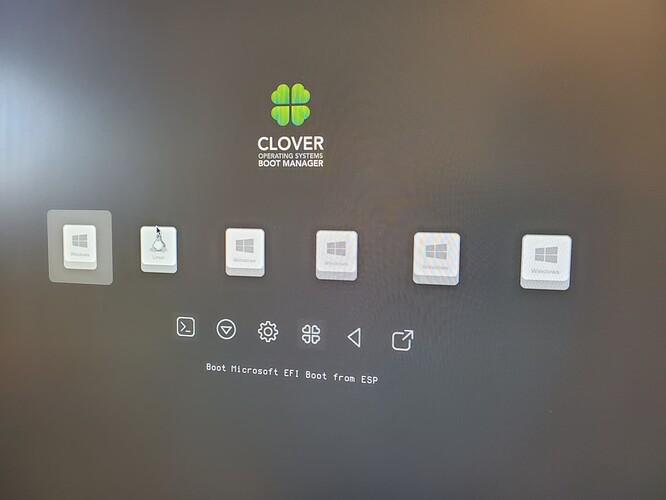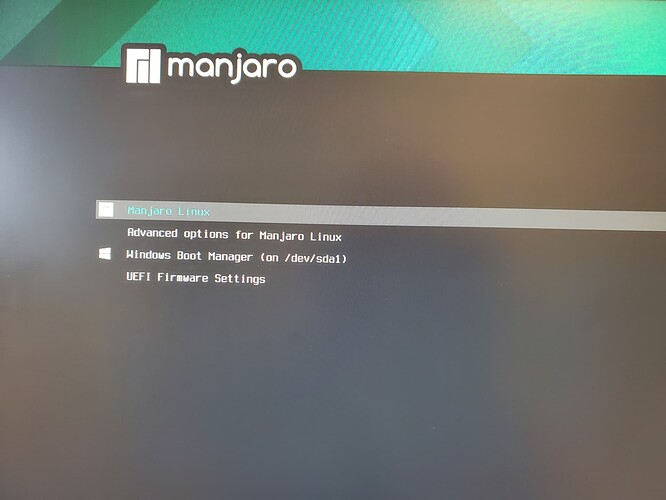Thanks for the tips! I read the wiki link and several more in addition to that. I don’t necessarily understand it all but it was helpful.
I’m not sure I’m doing this correctly but I did try getting the default Manjaro boot manager to load the NVMe driver that Clover uses. The hardest part was trying to specify the driver using efibootmgr as the documentation regarding the driver option is quite brief. Here’s what I did:
- Logged in as
su and copied the driver file that Clover uses “NvmExpressDxe.efi” to boot/efi
- Figured out syntax for adding driver reference (simply include
-r switch to perform operations on driver):
root@john-inspiron3668:/boot/efi$ efibootmgr -r -c -l NvmExpressDxe.efi
DriverOrder: 0000
Driver0000* Linux HD(1,GPT,3522000f-d2e4-4fb7-8950-40d276d124ba,0x800,0xfa000)/File(NvmExpressDxe.efi)
- I then changed order (NOTE: no spaces allowed in boot var item list) to prioritize the Manjaro boot manager over Windows boot manager (which was Clover-modified so it loads the NVMe driver for me). In this way I can test to see if the Manjaro boot manager is now loading the desired driver:
root@john-inspiron3668:/boot/efi$ efibootmgr -o C,1,0,A,B,7,8
BootCurrent: 0000
Timeout: 5 seconds
BootOrder: 000C,0001,0000,000A,000B,0007,0008
Boot0000* Windows Boot Manager HD(1,GPT,3522000f-d2e4-4fb7-8950-40d276d124ba,0x800,0xfa000)/File(\EFI\CLOVER\CLOVERX64.efi)57494e444f5753000100000088000000780000004200430044004f0042004a004500430054003d007b00390064006500610038003600320063002d0035006300640064002d0034006500370030002d0061006300630031002d006600330032006200330034003400640034003700390035007d00000000000100000010000000040000007fff0400
Boot0001* Manjaro HD(1,GPT,3522000f-d2e4-4fb7-8950-40d276d124ba,0x800,0xfa000)/File(\EFI\Manjaro\grubx64.efi)
Boot0007* CD/DVD/CD-RW Drive BBS(CDROM,P1: HL-DT-ST DVD+/-RW GU90N,0x0)0000424f
Boot0008 Onboard NIC BBS(Network,Realtek PXE B02 D00,0x0)0000424f
Boot000A* ST1000DM010-2EP102 BBS(HD,P0: ST1000DM010-2EP102,0x0)0000424f
Boot000B* USB Storage Device BBS(USB,Generic MassStorageClass1209,0x0)0000424f
Boot000C* Diskette Drive BBS(Floppy,Diskette Drive,0x0)0000424f
…
Unfortunately this did not work. The commands in this grub rescue shell are understandably extremely limited – ls was the only command that seemed to do anything:
So then I looked at the Clover method and figured that maybe there were other drivers necessary… so I copied all of them from /boot/efi/EFI/CLOVER/drivers/UEFI to a subdirectory I created called drivers (at /boot/efi/drivers); they were the following:
ApfsDriverLoader.efi
AptioInputFix.efi
EnglishDxe.efi
Fat.efi
NvmExpressDxe.efi
OpenRuntime.efi
VBoxHfs.efi
Then created an entry for each using efibootmgr and rebooted.
Didn’t work again. In fact, this time when using the boot manager chaining method (loading my Windows Boot Manager first) I could not get Manjaro to respond to my keyboard or mouse at the login screen. This seems to indicate that the drivers are in some way being loaded (and in this case conflicting with the default Manjaro drivers). I had to use the live Manjaro USB to delete the drivers to be able to get back in.
So I tried one more time but this time with just three of the drivers that I guessed might be needed:
ApfsDriverLoader.efi
Fat.efi
NvmExpressDxe.efi
…with the order as described below:
root@john-inspiron3668:/boot/efi$ efibootmgr -r -o 0,1,2
DriverOrder: 0000,0001,0002
Driver0000* Linux HD(1,GPT,3522000f-d2e4-4fb7-8950-40d276d124ba,0x800,0xfa000)/File(.\drivers\ApfsDriverLoader.efi)
Driver0001* Linux HD(1,GPT,3522000f-d2e4-4fb7-8950-40d276d124ba,0x800,0xfa000)/File(.\drivers\Fat.efi)
Driver0002* Linux HD(1,GPT,3522000f-d2e4-4fb7-8950-40d276d124ba,0x800,0xfa000)/File(.\drivers\NvmExpressDxe.efi)
This again resulted in the grub rescue however it did not lock up my mouse and keyboard when chaining boot managers.
Any thoughts? I’m not sure this approach of guess-and-check is the best way but I haven’t yet had enough spare time to read the developer training lessons such as found here:
https://www.intel.com/content/www/us/en/developer/articles/tool/unified-extensible-firmware-interface.html?wapkw=uefi%20shell
…
Another method?
What about just replacing the default Manjaro boot manager with the rEFInd boot manager? Is this difficult to manage seeing that it isn’t the boot manager installed by Manjaro?
https://www.rodsbooks.com/refind/drivers.html


